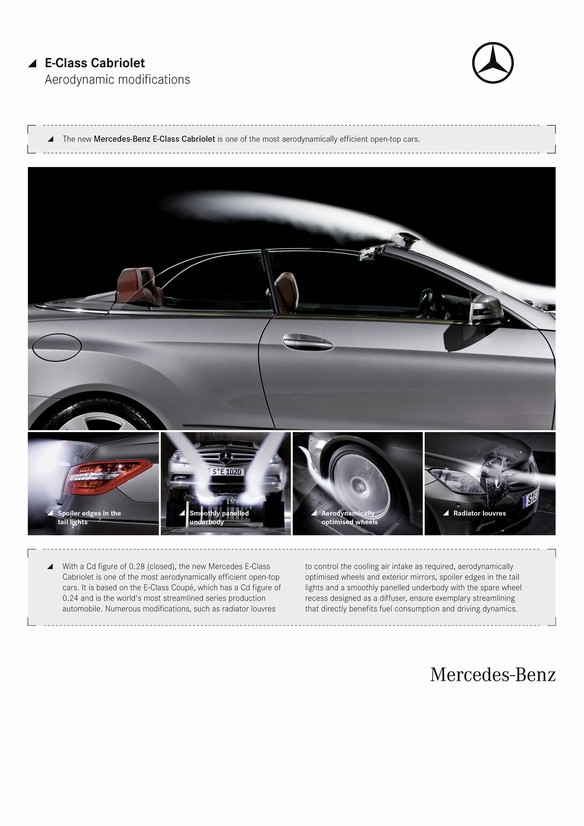From the early days through today:

Open-top cars from Mercedes-Benz

- From A to F: great variety of Cabriolet versions in the first half of the 20th century
- Open-top cars of high refinement have always been a part of the model portfolio
Stuttgart – The cabriolet celebrates the pleasure of driving perhaps more than any other body shape. Travelling with the top down and the wind swirling around the passengers is locomotion at its freest, an elegant and exclusive privilege. At least this is how people see it since the 1920s. Prior to that, open bodies dominated the entire automotive landscape.
The cabriolet is not as racy as the related sports car, the roadster, but more open and airy than the convertible saloon, whose door frames extend to the roof line. Completely open behind the windscreen and featuring retractable side windows and a passenger compartment that can be protected against the elements by a sturdy folding top, the body variant “cabriolet” has secured itself a prominent place in the family tree of car evolution.
This branch of the motor vehicle family repeatedly has brought forth exceptional cars at Mercedes-Benz: from the early cabriolets of the 1920s through the 170 V Cabriolet B (W 136 series) of 1936 to the finely chiselled fabric-top Cabriolet of the E-Class that will go on sale at the end of March 2010.
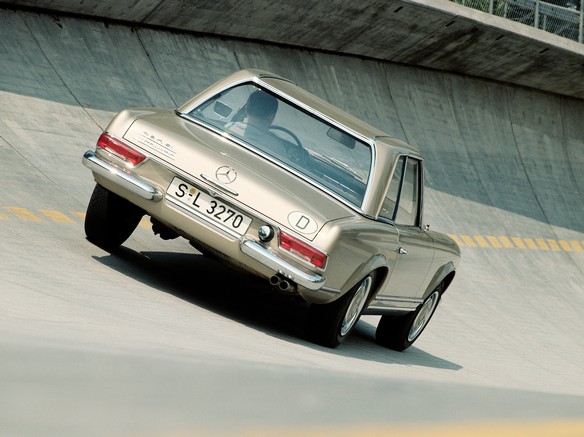
Cabriolet capers
Like many other body designs, the cabriolet concept harks back to the coach age: a “cabriolet” was a light, open carriage drawn by two horses. This vehicle was reserved mainly for pleasure trips in fine weather. And this is where its name comes from: in French the verb cabrioler means “jumping for joy”, “cutting capers”. But driving with an open top for a guaranteed good mood required no special body shape yet in the early years of the automobile because open automobiles were characteristic of the period between 1886 and 1920.
When closed bodies became established in the first third of the 20th century, in addition to the saloon and coupé with their hard bodies coachbuilders also offered the landaulet – and the cabriolet, whose top could be completely opened. Characteristic of this car type even in the 1920s was a sporty and elegant silhouette, and the possibility of opening the car entirely above the door upper edges. With the top closed, from the side the cabriolet looked like the coupé. And today most cabriolets are based on coupé bodies.
Bridge between touring car and saloon
The automobile, that technical marvel, found to its modern form by 1900, marking the end of the epoch of designs whose appearance even Carl Benz, in 1925, compared with a “coach cut short at the front”: the motor vehicle grew in length, its centre of gravity lowered. As the speed rose, customers called for protection against wind and weather. More protection than that afforded by the soft coach tops of the first automobiles.
The saloon and coupé body shapes, as well as the landaulet, now took their place alongside touring car and phaeton. From the 1920s onward the cabriolet functioned as a bridge between these two interpretations of the automobile: its top could be opened just as wide as that of a touring car. However, its material and the supporting structure were designed so strongly that when the top was up the ride comfort compared with that of a saloon.
Customers of the period could choose from a number of cabriolet models. Vehicle manufacturers and coachbuilders had not yet made acquaintance with the problem that exists nowadays of reinforcing the floor structure for the sake of the body’s rigidity: whereas today’s integral body constructions demand a complex special construction for the cabriolet, up to the Second World War chassis-cum-frames on which, according to taste, different bodies could be mounted were customary. On the other hand, in several model series of
Mercedes-Benz the frame sections varied in stability depending on the body to be mounted.
A special form and not a cabriolet in the proper sense is the touring car with add-on top available in the first half of the 1920s from Daimler-Motoren-Gesellschaft: the six-seater touring car got a superstructure, much like today’s hardtop, that afforded protection from the weather as good as that in a Pullman saloon.
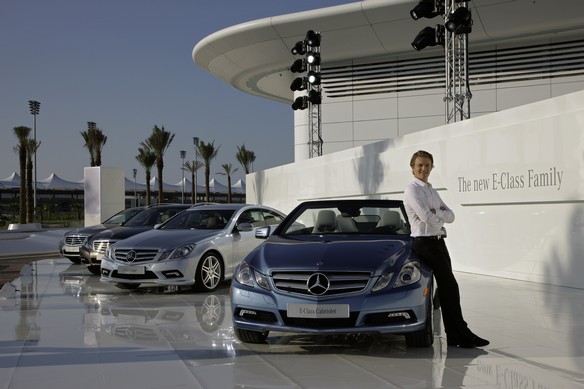
From A to F: the cabriolet alphabet
Cabriolets soon were available in many different models. To bring some transparency into this variety, at Daimler-Benz cabriolets were classified into six common types designated by the letters A to F. The lined, all-weather, fabric folding top stabilised by a linkage is common to all of them; the top is heavier-duty in versions D to F than on models A to C. Into the 1950s it was also customary to support the mechanism of the tops of Mercedes-Benz cabriolets with an externally visible so-called landau linkage.
- Cabriolet A is a two-door, usually two-seater car. Its top reaches to the doors.
- Cabriolet B likewise has two doors, but four seats and side windows for the rear passengers.
- Cabriolet C is similar to Cabriolet B in the layout of its doors and seats, but the rear side windows are missing.
- Cabriolet D is a four-door with four or five seats and a heavier top.
- The very rare Cabriolet E has six seats and the heavier top. Cabriolet F is similar to model E, but additionally has side windows behind the rear doors. Both have four doors.
Seldom does a single model series fully cover the broad range of possible versions, at least not in series production. For instance, the six-seater variants E and F automatically are reserved for the big, prestigious cars. Moreover, the manufacturer strived to keep the number of variants for cars with production bodies manageable. As custom-built products from the factory, and above all as individual bodies fashioned by independent manufacturers, for example Balzer, Castagna, D’Jeteren & Frères, Farina, Geissberger, Hibbard & Darrin, Neuss, Papler, Saoutchik, Tschau and Van den Plas, numerous extraordinary cabriolets were produced as one-offs well into the 1950s.
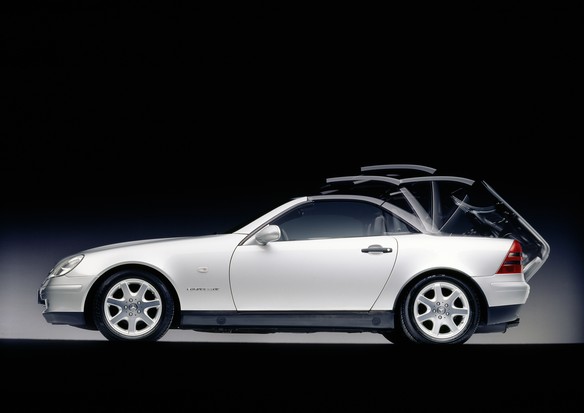
Open tops carried over into the merger
Daimler-Motoren-Gesellschaft was already offering the 1924 Mercedes models 15/70/100 hp and 24/100/140 hp as four-seater cabriolets and open touring cars. These cabriolet models continued to be carried as Mercedes-Benz models following the merger with Benz & Cie. to form Daimler-Benz AG in 1926. With their steeply angled windscreens they still lacked the charm of elegant sportiness; only the voluminous folds of the soft top at the rear distinguished them from the coarser touring cars.
However, the cabriolet versions of the 8/38 hp model (W 02) already developed a design idiom of their own. Especially the two-seater Cabriolet A scored high with smart sportiness combined with practicality, that is to say good weather protection. While this model also was available with two doors and four seats, the 12/55 hp model (W 03) and its direct successors were already offered by
Mercedes-Benz with three different body styles as cabriolet ex factory. From the more staid but imposing four-door to the comparatively racy two-seater with tightly tailored top, this family of models provided a preview of the whole range of variants with which the cabriolet theme would be interpreted in the years to come.
The legendary models S, SS and SSK are touring sports cars. Mercedes-Benz itself offered the S and SS as a two-door, four-seater Sport-Cabriolet from 1926 to 1934. Were it not for the breathtakingly long bonnet that set this car apart from its contemporaries, from a matter-of-fact standpoint one could speak of a Cabriolet C of this series designed for racing and sporty driving. As of 1928, though, anyone wishing to have a Cabriolet body fitted to the SSK had to turn to one of the fine shops specialising in such coachwork: the Mercedes-Benz model list contained no SSK Cabriolet. Models 15/70/100, 24/100/140 and the K covered the segment of open touring cars.
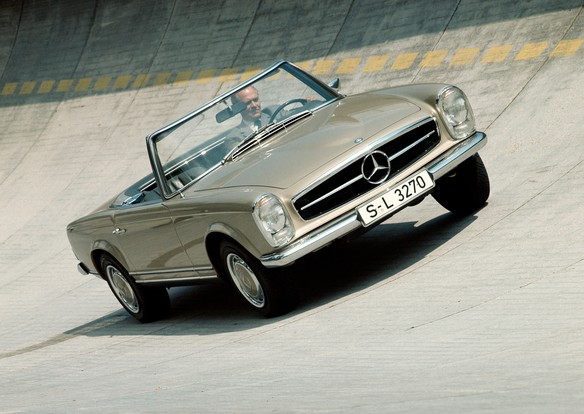
Cabriolets in all sizes
In the years up to the Second World War, Mercedes-Benz offered cabriolets in practically all model series. The Stuttgart 200 was available in versions A, B and C; the Stuttgart 260, additionally as a Cabriolet D. The Mannheim model could be had as a Cabriolet C and D; the two-seater Cabriolet A with its particularly sporty design was offered as a “Sport-Cabriolet”. In his brand history, Mercedes-Benz chronicler Werner Oswald emphasises the great importance of the dynamic aesthetics of these vehicles versus the actual performance: “These cars were not at all particularly fast or powerful, and getting in when the top was closed called for acrobatic agility. But the lines were so stunningly beautiful that many people were willing to dispense with other things for their sake.”
Even the model 770 “Grand Mercedes” (W 07), prestige cars were available as Cabriolet B, C, D and F; in addition, there were special bodies like the two-seater Cabriolet from Auer. In the W 150 series, the second version of the 770, from 1938 on Mercedes-Benz limited its offer to the absolute prestige variants in the shape of Cabriolet D and F. At a list price of 47,500 Reichsmark the latter was the most expensive version of the W 150. Only a single specimen of a Cabriolet B of series W 150 is known.

Diesel cars with fresh air supply
But the cabriolets from Mercedes-Benz differed not only as to the bodies in the 1930s. Distinctions were made between the cars with the folding tops under the bonnet as well. Since adopting the new body of the Mercedes-Benz 230 in 1937, model 260 D (W 138) was available not only as Saloon and Pullman-Landaulet, but as Cabriolet B and Cabriolet D too.
The 380 model gives an impression of how the body versions were distributed within a model series: from 1932 to 1934, 54 Cabriolet B, 44 Cabriolet C and 16 Cabriolet A were bodied by Mercedes-Benz in Sindelfingen. This compares with only eleven open touring cars, seven roadsters and six saloons of the same model.
Cabriolets for the “economic miracle”
Type 170 V (W 136) was offered by Stuttgart as a Cabriolet A and B from 1936 on (as a Convertible Saloon and Roadster too). But when production resumed after the Second World War with this largely unchanged model, no more 170 V Cabriolets came off the assembly line in Stuttgart. This body shape had permanently established itself as something special, a niche car, while the saloon became the standard version. In the post-war period with its shortage of everything, rather scantily equipped versions of series W 136, referred to by the abbreviation OTP (Open Touring car Police), were built only for the police.
Model 170 S (W 136 IV) was the first available as Cabriolet (A and B) from 1949 on. For the young Federal Republic of Germany these open-top cars with the new bodies were the epitome of sporty-luxurious driving. From a present-day perspective, their elegant lines were like a harbinger of the so-called economic miracle of the 1950s. But just two years later the 220 (W 187) with its Cabriolet versions superseded the 170 S. The price of the 220 underscored Mercedes-Benz’s claim of offering an exceptional and luxurious vehicle: the Saloon could be had for 11,935 deutschmarks, while the Cabriolet B carried a price tag of 15,150 marks and the fine two-seater (Cabriolet A) 18,850 marks. The classic cabriolet culture of the pre-war period re-echoed when Mercedes-Benz introduced its new prestige saloon, the model 300, in 1951. It could also be had with a soft top as Cabriolet D – a really handsome car. Type 300 S (W 188) on the other hand was offered by Stuttgart as a Coupé, Cabriolet A and Roadster.

Open, sporty, refined: the Mercedes-Benz SL tradition
In 1954 the 300 SL debuted as a Coupé, to be superseded in 1957 by the Roadster. This open-top 300 SL is the forefather of a series whose tradition is unbroken since then. For more than 50 years the SL model family has kept alive the tradition of open-top cars with soft tops in the Mercedes-Benz model range.
Compared with the original concept of the Roadster with inserted side windows and a thin top, by contrast the open SL models are a successful combination of sportiness and elegant motoring. They thus continue the tradition of the gracefully designed Mercedes-Benz Cabriolet A: open, sporty, refined.
There is one more Mercedes-Benz two-seater of the 1950s that uses the abbreviation SL in its name: the 190 SL derived from the “Ponton” series W 120/121. This beautiful Roadster with the genes of the 190 set standards for the design of open-top cars in its era.
The idea of the cabriolet in the 20th century
With the W 180 series, beginning in 1954 the Cabriolets of
Mercedes-Benz entered a new era: the integral body construction demanded a break with the custom of offering a large number of different cabriolet versions; rather the designers sought to create an elegantly designed open-top touring car that could match the Saloons of the series for comfort and safety.
This called mainly for constructional measures to improve the rigidity of the Cabriolet body of models 220 S (W 180) and 220 SE (W 128), whose frame-floor unit was 120 millimetres shorter than the Saloon’s. But the design of the folding top was new too: the first post-war Cabriolets of models 170 S, 220 and 300 as well as 300 S still featured the typical external tensioning arms, whereas the Cabriolet A/C introduced at the 1955 Frankfurt International Motor Show (IAA) now sported a soft top designed with a smooth exterior; it was supposed to cover two body variants, hence the designation A/C. So on the outside, the roof of the Cabriolet now approached that of the Roadster. Though the formerly strict division between the two body types was not completely eliminated, the two variants moved closer together.
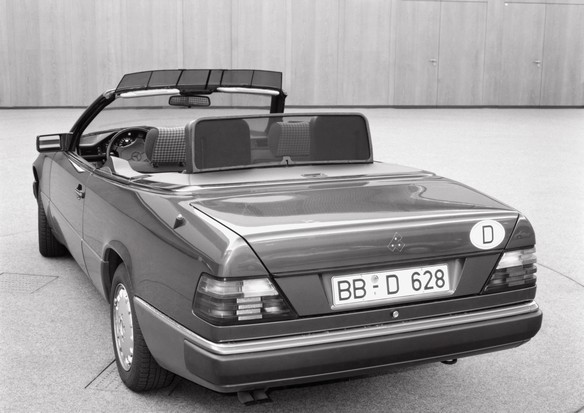
Luxury-class cabriolets
The status of the Cabriolet as an exclusive body design was emphasised by Mercedes-Benz also in series 111 and 112 from 1961 to 1971: models 220 SEb and 300 SE were based on the Coupé body and were a delightful interpretation of a luxury-class cabriolet. The lines of the open-top S-Class predecessor were so inspiring that the Cabriolets continued to be built on the basis of the W 111 and W 112 even after the W 108 was introduced to the market.
In the ten years in which they were built, Mercedes-Benz offered five different Cabriolets in this series: 220 SEb, 250 SE, 300 SE, 280 SE and 280 SE 3.5 – in all, Sindelfingen produced 7013 units of the five Cabriolets. For the time being there would be no sequel to this generation of open-top luxury-class cars in the model range of Mercedes-Benz. Instead, beginning in 1971 it was the new SL of series 107 that cultivated the culture of open-top driving as a two-seater among the automobiles of the Stuttgart make.
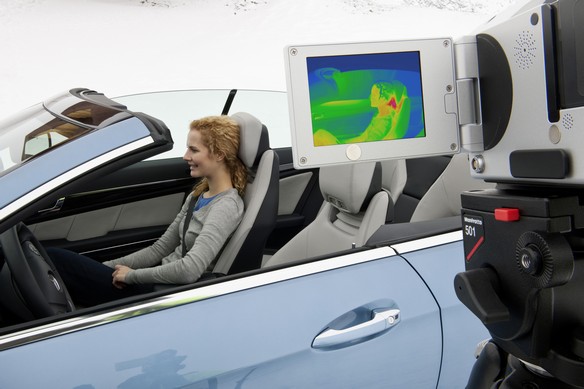
Comfortable cruising on a sporty note with a folding top
The first two SL models from Mercedes-Benz already had explored the possibilities for interpreting the roadster body in the 1950s: on the one hand, the 300 SL of the W 198 II series with its characteristic space frame derived from the uncompromising Gullwing sports car; on the other hand, the 190 SL (W 121) as an elegant touring car for two with a comfortable soft top.
The W 113 SL series of 1963–1971 combined the best of both worlds: On the one hand, the Roadster delivered remarkable performance; on the other hand, it afforded great ride comfort for refined travel in an elegantly designed safety body. Unlike the classic Cabriolet, however, a hardtop was provided to protect the Roadster specifically against the inclement weather that prevails from late autumn to early spring. The characteristic shape of this inward curving hardtop roof lent the series its nickname “pagoda”; as usual the soft top was convexly shaped.
The new SL of the 107 series evolved even more into a luxurious and powerful open-top two-seater. Mercedes-Benz introduced the Roadster with the internal designation R 107 in spring 1971. It was closely related to the SLC Coupé presented in 1972. In this case the engineers did not derive the open-top car from the Coupé; it was the other way around: the Roadster was the basis of the closed-body four-seater.
The series R 129 SL did not take the place of its successful predecessor until 1989. Not only the balanced design of the new sports car was impressive, it featured a number of technical innovations as well. They included the premiere of the automatic roll-over bar, which is raised into position within 0.3 seconds when the car threatens to turn over. The Mercedes-Benz engineers also further improved the stability of the open body in this SL generation without impairing the flowing lines of the open-top sports car.
A roof of steel takes the coupé concept closer to open-top driving
In 1996 Mercedes-Benz revolutionised the concept of open-top driving with the Mercedes-Benz SLK of the R 170 series: the folding top of the compact sports car was made of steel, not fabric. The developers therefore spoke of a “vario roof” and no longer a folding top. The steel roof, when closed, gives the open sports car much of the comfort of a coupé. Within a few seconds though it opens wide at the touch of a button, hydraulically, to let in the sun. The successful concept of the steel-topped Roadsters was adopted in 2004 by the Mercedes-Benz SLK of the R 171 series.
The SL of the R 230 series launched in 2001 also features a retractable steel roof with a rear window made of glass. In this big, powerful sports car, the balance between high comfort and elegant silhouette (with the top up) and driving pleasure (with the top down) is especially palpable and impressive.
No renunciation of the classic fabric top
With innovative steel-and-glass roof constructions in the SL and SLK, Mercedes-Benz sets standards for the engineering of open-top cars in the 21st century. But the designers and engineers do not lose sight of the tradition of the classic Cabriolet with fabric top.
The continuity of a very special vehicle has helped ensure that: since 1979 the cross-country vehicles of the G-Class are available also as robust Cabriolets – though admittedly they are hardly perceived as such by the public because an open design is quite typical of cross-country vehicles.
Mercedes-Benz did not pursue this classic approach again until September 1991, after a 20-year pause, when a four-seater Cabriolet based on the Coupé of the 124 series made it appearance. Its body not only was reinforced to make an open top possible; sophisticated design features additionally protected it against vibration.
And so in a very positive sense a classic Cabriolet emerged that successfully appealed to a different target group than the buyers of the open-top SL sports cars. When production of the 124 series ceased, the tradition of this E-Class Cabriolet was continued by the open versions of the CLK-Class, the A 208 (1998 to 2003) and the A 209 (2003 to 2009). Finally, the E-Class Cabriolet will make its appearance at the end of March 2010 – again with a classic fabric top.
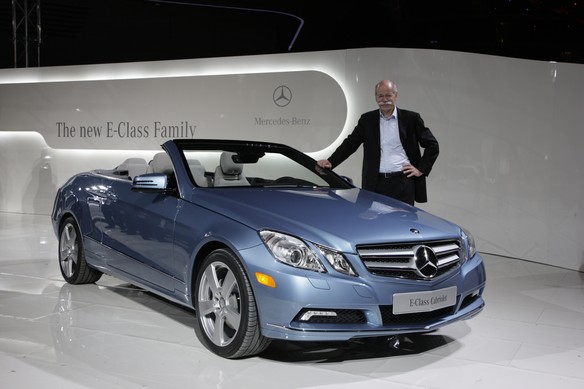
Open for new ideas
Travelling in an open car has been the subject of new interpretations ever since the invention of the automobile. What was simply the norm in the first years increasingly became the avowal of a distinctive form of sporty, refined driving in the first third of the 20th century. The Cabriolet is the body design that best meets this requirement. This is true particularly of the open-top cars from Mercedes-Benz.
In the history of the brand, time and again the Cabriolet has been further refined – the engineering as well as the design and the image of this type of vehicle in the collective perception. But there are constants nonetheless. Cabriolets always have proved to be automobiles of an exceptional kind, positioned since the 1920s at the interface between tradition, elegance, luxury, and the excitement of the unspoilt sensation of topless driving.
And Mercedes-Benz is always open for new ideas for driving without a fixed top. The E-Class with its four-seater Cabriolet underscores that. And in January 2007 the Mercedes-Benz “Ocean Drive” study enthralled the crowds at the North American International Auto Show in Detroit. The four-door Cabriolet based on the Mercedes-Benz S 600 is an excitingly new interpretation of the classic idea of the large, luxurious car with a soft top – a promise for the future of the Cabriolet.
